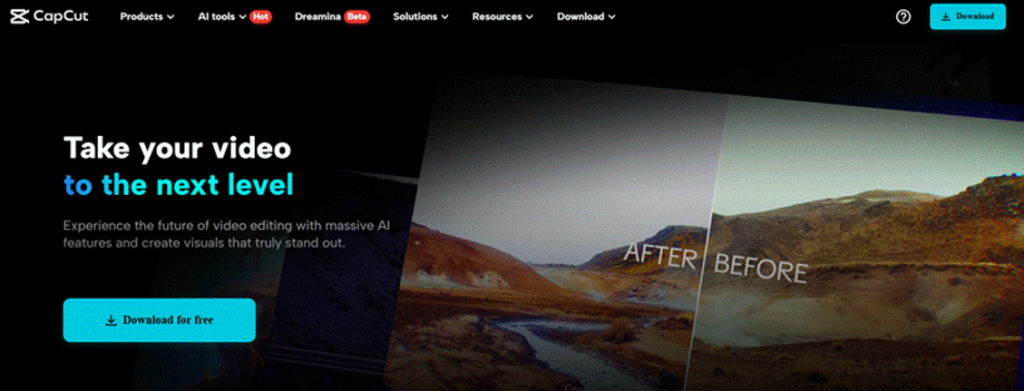It is difficult for most teachers, tutors, and students to create videos that explain class material in a simple and entertaining manner. If lessons are text or static images only, it may be difficult to engage students.
Increasingly, schools now employ animated videos to enhance learning. The videos transform difficult concepts into easy stories or moving images. Students learn quicker and retain more.
If you wish to infuse life into your class material, the CapCut desktop video editor is an excellent utility. It enables you to create lessons with motion, voice, and sound without requiring professional skills.
Applying animation to your videos makes lessons new and concise. It redefines how students perceive and understand school subjects. It’s a clever method of teaching in this era.
Animating Class Concepts with CapCut Desktop Video Editor
With the CapCut desktop video editor, educators can make class concepts into understandable and compelling images. You can demonstrate how things are done, such as the phases of the water cycle or components of an arithmetic problem.
Animations make students view and comprehend what you teach. They make lessons more comprehensible than simple pictures or lengthy text.
Features such as timeline editing, keyframe motion, and pre-made effects make it easy to construct these lessons.
Most of the features are free, but some of the tools will cost you. Some of these include sound tools, overlays, and the built-in text to speech feature that allows you to insert voice without having to record yourself.
Why Use Animation in Educational Videos?
Animation is easier to learn from because it helps students pay attention and absorb information more. It gets them hooked and continues to engage them.
Tough subjects such as photosynthesis or the water cycle are difficult to describe with words alone. However, if you demonstrate them in motion pictures, students will get the point faster.
Animation makes learning enjoyable and more memorable. It also assists learners who are more visual or auditory and prefer not to read.
Most teachers use devices to bring more life to lessons. For speedier results, you can experiment with using an AI video generator.
It assists in producing quick animated videos from your lesson outline, making your lesson contemporary and trendy.
Key Features of CapCut Desktop for Academic Animation
The CapCut desktop video editor makes it easy to teach. The keyframe animation allows you to move images, objects, and text to make diagrams or ideas come alive.
Pre-defined motion effects move static photos, and students remain interested. Stickers, shapes, and overlays can be used to emphasize lesson points as well.
The green screen functionality enables the possibility of merging live-action footage and animations for emphasis. Although many tools are supported by CapCut PC, additional advanced features will only be realized with a paid plan.
Reasons to Pick CapCut PC for Animation Instead of Other Alternatives
It is much easier to use compared to other professional animation software, which is otherwise complicated. This makes it suitable for teachers without much video experience. You can produce videos quickly with templates and pre-set effects, saving time.
CapCut also integrates well with mainstream platforms such as Google Classroom and Moodle, making it easy to share videos.
It even has a voice changer, assisting teachers in adding diversity and interest to lessons, particularly in gamified or narrative videos. Be sure to download CapCut PC only from the official website for safety and reliability.
How to Animate a Class Concept Video with CapCut Desktop
Step 1: Download & Import Classroom Content
First, download the CapCut desktop video editor from its official website. It’s absolutely free to start, though some of the advanced features are paid. Install the editor, then open it up and begin a new project.
Click on the “Import” button to import your class content. Add images, slides, video recordings, or other educational materials directly in the timeline to begin working on your video project.
Step 2: Add Animation and Educational Enhancements
It’s time to animate your content now. Utilize keyframe animations to push objects, text, or images around on the screen. You can also add transitions between scenes to create a smooth flow for the video.
Add text overlays to describe the concepts or main points. Animated arrows, labels, and illustrations can simplify complex subjects.
If you have screen recordings, you can add animated callouts to mark important sections. These features make your lessons more engaging and easier for students to follow.
Step 3: Export and Share
Once you’re satisfied with your video, it’s time to export. Click on the “Export” button and select the resolution and format you desire.
You can publish the video on class portals, YouTube, Google Drive, or your learning management system (LMS). Be aware that if you utilize some premium features, a watermark will be added to your video.
Conclusion
Animated videos play an immense role in engaging students and learning. They transform lessons into interactive forms that are simple to comprehend.
The CapCut desktop video editor can assist teachers in animating class material so that it comes alive. It is free to begin with, although some advanced features might be paid for.
Try out the CapCut PC to turn your static lessons into energetic, animated courses that will engage your students and assist them in learning better.



